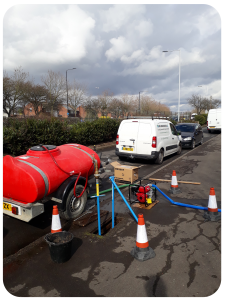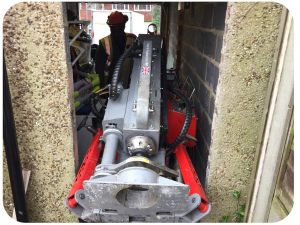Phone : 0800 470 3410
Phone : 0800 470 3410
As part of our SuDS strategies we often recommend soakaways as mitigation for surface water run-off. The feasability of a soakaway at a site needs to be determined prior to installation by undertaking infiltration testing.
Infiltration Testing is a type of field test to determine the infiltration rate of a particular area’s soils and explore the subsurface conditions underneath the soil or pavement surface. The “infiltration rate” refers to the speed at which water enters into the soil.
To do this we excavate a trial hole (typically 1.0m length * 0.5m breadth * 1.5m depth) in an area of ground before filling it with water, in order to calculate the infiltration rate.
This process may seem simple at first, however many sites issues with respect to availability of running water. Even when water is available, a normal tap can take hours to fill the trial hole.
To solve the problem, we have recently acquired a new water bowser and water extraction licence from Thames Water. Our site crew have also been trained in using excavators. As a result, our soakaway test capabilities have grown massively enabling us to undertake more Surface Water Assessments.

STM was recently appointed by a concerned home owner who wanted to redevelop his property which is partially located within a functional floodplain in Chertsey. However, the EA informed that the current best available flood modelling of the site was considered to be out of date and therefore insufficient for site specific designs.
STM were requested to undertake detailed modelling at the site. STM undertook detailed topographical surveying of the channel and surrounding area and produced a new hydraulic model which showed the flood risk at the site could be adequately managed. The output from the model was also handed over to the EA who were able to use it to update their flood maps.
As part of the works, we provided a level for level, storage for storage compensation scheme. We also undertook soakaway testing in line BRE 365 and provided SuDS recommendations to reduce surface runoff and recommended flood resilience construction methods to make the development flood resistant.
STM firmly believes in collaboration, understanding and participation between all parties throughout the project. We worked closely with the EA and came up with a flood mitigation and resilience scheme for the new development. The client was over the moon with the works as it saved him from having to construct his finished floor levels at a much higher elevation.
commentA Client recently contacted us requesting that we carry out a Phase 1 on a Brownfield site which they wished purchase in order to develop residential dwellings.
Although planning permission for the development had been granted, the Local Authority had placed a Contaminated Land Condition requiring Contaminated Land Risk Assessment to be undertaken prior to the commencement of the development.
STM carried out the Phase 1 Report, which identified that the site had previous contaminative uses including a Builders Yard. The results of the subsequent intrusive site investigation revealed elevated concentrations of Lead and Asbestos in soils in the area that was intended for use as a communal garden. This meant that Remedial works were required in order to render the site suitable for the proposed residential end use.
STM further assisted the Client by undertaking the remedial works, saving them tens of thousands of pounds. As the risk assessment had been conducted pre-purchase, the Client was also to negotiate a reduction in price for the property with the seller.
This case study serves as a stark warning of the dangers of not conducting your Environmental Due Diligence prior to acquisition of any Brownfield property.
Flood Risk Assessments measure the likelihood of flooding within your local area. As well as this, it explores what measures you can take to mitigate when it happens.
The Environment Agency (EA) and Local Lead Flood Authorities (LLFA) are the organisations involved with flooding. They decide which areas are at the highest risk of flooding. They do this using complex computer modelling, based upon historical floods.
After flood-modelling, the EA ranks areas in order of severity. These ranked areas are then mapped, to indicate what areas are at risk of flooding, and what severity the flood risk is. Using the mapped areas, consultants like us, can assess the risk of flooding to your project.
This involves projecting flood risk over time, to determine if your project is vulnerable, as flood risk is likely to increase with time. As well as this, we determine how changes of your development will affect the local area.
There are three levels of Flood Risk Assessment:
We as consultants, then write a report, which you submit to the Local Authority. Our tailored reports have been honed to ensure the highest level of successful application.
comment
STM is proud to announce that we have purchased a new Dando drilling rig
The new rig will enable us to complete more complex investigatory works, having been designed specifically for site investigation and environmental analysis. The rig has an ultra-small footprint and crawler mounted design to enable the user to carry out various sampling methods in confined spaces where access is limited.
The staff here at STM are all excited to begin using the new kit, which has already been utilized on some of our more recent site investigations.

STM were recently requested by an IPPC Company owner (Client) to undertake a Environmental Due Diligence Assessment (EDD) for their operational industrial site. The company, a very successful operational metal works, was due to be sold to foreign investors. The transaction had stalled due to the potential that the land may have been contaminated. As a result the purchaser was reluctant to take the next step.
Read more about this in the Case Study
commentA developer recently successfully appealed against a Contaminated Land Determination Notice served on him by Walsall Council in respect of a gas works that had been redeveloped to housing in the 1970’s.
In only the second determination by the Secretary of State since the contaminated land regime came into force, this determination shows that Local Authorities need to follow the guidance to the letter when making determinations.
Click here to access the full details of the case on Walsalls homepage.
commentSTM Environmental was recently approached by a local council to map out areas of potentially contaminated land within the local region. This project spanning a number of epochs ranging over 200 years involved sifting through old maps with a fine tooth comb in order to pick out sites of potential contamination, ranging from old industrial factories to more modern hospitals.
STM was recently approached by Hounslow Council to geo-rectify some aeiral maps of the council district. Hounslow provided a wealth of old aerial photo scans, taken from planes throughout the last few decades, with the task of mosaicking the images so that they alligned with Ordnance Survey MasterMap data.
Getting to know Hounslow from the skies over the years proved to be an interesting project, with well known sites being visible from the aerial photos, such as the old Twickenham Stadium, as shown below!
Continued servicing of both the public and private sector. Due to our continued expansion and growth, the STM team feel our new clientele will appreciate the knowledge that our consultancy expertise is being utilized within both the public and private sectors.
STM was approached to undertake a Flood Risk Assessment and create Surface Water Drainage Strategy for La Reserve Hotel London. The Flood and Drainage team utilized their experience of flood risk within central London and their knowledge of surface water drainage SuDS systems enabled a quick turn-around and allowed for flexibility and alterations to the design and drainage strategy.